.

There is surely no more impressive site in the world than the Temple of Apollo at Delphi on Mount Parnassus; of all the glorious holy places, this site of the Oracle of Delphi established the link between music and mystery.... The word music itself comes for the Greek word musiki, meaning all the arts of the nine Muses. Apollo, son of Zeus, was the leader of the Muses, as master athlete and warrior as well as master musician. Mount Parnassus came to be thought of as the home of music. Yehudi Menuhin, The Music of Man
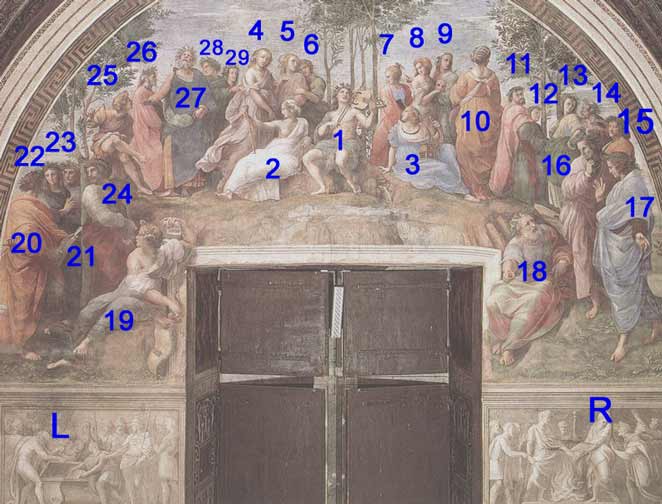
Parnassus is the place of the Oracle of Delphi, the center of the Greek World, founded by Apollo Delphinios as a Homeric poem describes:
I sprang upon the swift ship in the form of a dolphin,
pray to me as Apollo Delphinius; also the altar itself
shall be called Delphinius and overlooking for ever.
Details
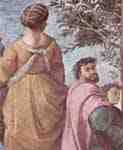
Stanza della Segnatura : The Parnassus , detail
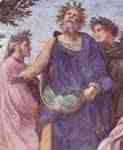
Stanza della Segnatura : The Parnassus , detail

Stanza della Segnatura : The Parnassus , detail
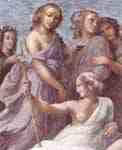
Stanza della Segnatura : The Parnassus , detail
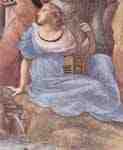
Stanza della Segnatura : The Parnassus , detail
The Parnassus of Raphael is a painting with some hidden messages. Apollo in the center plays music with a modern musical instrument. Raphael knew what instruments were used by the ancient Greeks as the Lyre of Sappho shows but he decided Apollo to play a Lira da Braccio. The poets are not chronologically ordered. Homer, Virgil and Dante are close together even if they are separated by up to 2000 years. Maybe the message was that poetry (and music) is timeless.
Like in the School of Athens where the most important representative philosophers until the period of Raphael are shown the Parnassus shows the most emminent persons of Literature. The central figures are Apollo and his Muses and Homer. He recites his poems, probably singing and only one person, Ennius the youngest, actually seems to be interested. Dante behind Homer almost provocatively ignores what he says.
The central figures are Apollo and the Muses. The Muses are personifications of the Liberal Arts but more than that they represent the creative process, the inspiration necessary to be a good author and poet. Apollo is assosiated with the Muses and light and thus probably he represents the enlightment, the Rennaissance period. The Greeks are represented with Apollo and the Muses, Homer, Sappho, Alcaeus and Anacreon.
The Parnassus with The Disputa, The Cardinal Virtues, and The School of Athens is one of the four frescos of Raphael of the Stanza della Segnatura in the Vatican Palace. It was produced in the preiod 1510 - 1511 for Pope Julius II..
Apollo and the Muses in the centre with groups of poets a little lower on either side and other groups filling the spaces to right and left of the window head. At first sight the design seems less symmetrical and formal than the others, with a lyrical freedom befitting the subject, but in reality it is no less perfect in its ponderation. The group of trees above Apollo and the reclining figures either side of him accent the centrality of his position. From this point the line of heads rises in either direction to the figures of Homer and of the Muse whose back is turned to the spectator, and the perpendicularity of these two figures carries upward into the arch the vertical lines of the window. From this point the lateral masses of foliage take up the drooping curve and unite it to the arch, and this curve is strongly reinforced by the building up toward either side of the foreground groups and by the disposition of the arms of Sappho and of the poets immediately behind her, while, to disguise its formality, it is contradicted by the long line of Sappho's body, which echoes that of the bearded poet immediately to the right of the window and gives a sweep to the left to the whole lower part of the composition. It is the immediate and absolute solution of the problem, and so small a thing as the scarf of the back-turned Muse plays its necessary part in it, balancing, as it does, the arm of the Muse who stands highest on the left and establishing one of a number of subsidiary garlands that play through and bind together the wonderful design Kenyon Kox
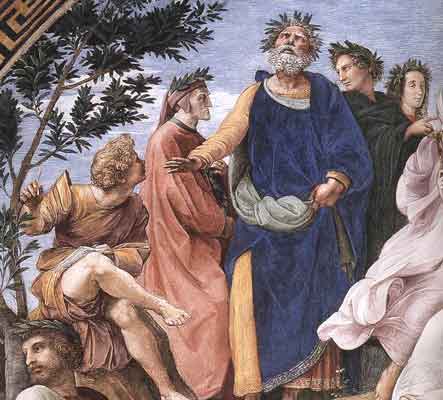
The Blind Homer "Homeros" singing his epic poems. Dante Alighieri with the red dress and a serious angry look "communicates" with Virgil on the right side of Homer who looks at Dante "back in the future" .

Clio, Thalia, Terpsichore, Euterpe, Polyhymnia, Calliope, Erato, Urania, Melpomene from a Roman Sarcophag
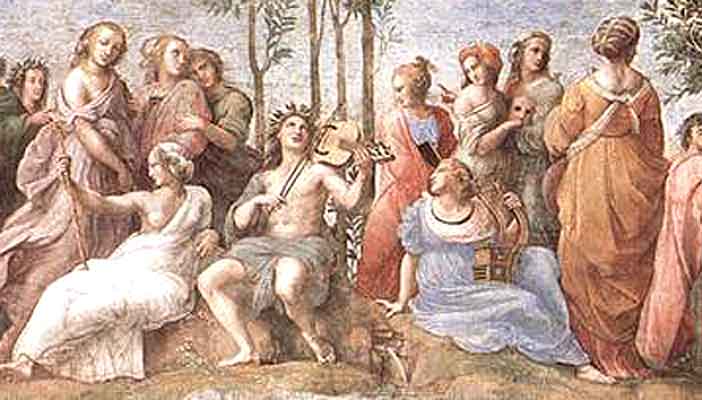
Apollo as Mousagetes "Muse-leader" sitting under a laurel tree playing a Lira da Braccio with the nine Muses
Persons
1

2 - 10 The Muses
Calliope (Beautiful Voice) – epic poetry. (Mother of Orpheus) (Orpheus Illustrations)
Euterpe (Delight) – music.
Erato (eros (love) Lovely One) – love poetry.
Thalia (thallein (to bloom), Festivity) – comedy.
Clio (kleos(glory) / kleiein (to celebrate) / Celebration/Fame) – history.
Urania (ouranos (sky) Heavenly One) – astronomy.
Terpsichore (Delight of dancing/choruses) – dance.
Melpomene (melpein (to sing) the Singing goddess) – tragedy.
Polyhymnia (poly (many) and hymnos (hymn) or mnasthai (to remember) Many Songed/Hymned) – sacred poetry. (considered also as inventor of the lyre)
2

Inspired by Ariadne ?
3

4

5

6

7

8

9
10

11
Plautus

12
Terence
13
14
Sannazaro
15
Cornelius Gallus
16
17
Horace / Quintus Horatius Flaccus, Roman poet, (8.12.65 BC – 27.1.8 BC)
18
19

20

21

What is this object in his hand, A handy ???: -)
22

23
Petrarch (1304 – 19.7.1374)

Petrarch (not shown here conversing with Anacreon, Alcæus )
24
Berni

25
Scribe
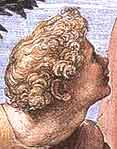
26
Dante Alighieri, (13.5.1265 – 14.9.1321) "The Divine Comedy"
Dante in Canto II of The Inferno:
O Muses, o high genius, aid me now!
O memory that noted what I saw,
Now shall your true nobility be seen!
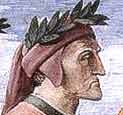

1971. Germany celebrates Dante 650 years after his death
27
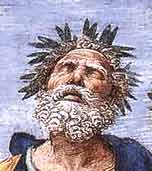
28
Virgil, (Publius Vergilius Maro) (15.10.70 BC –19 BC) Roman poet

29 ?

L Alexander the Great
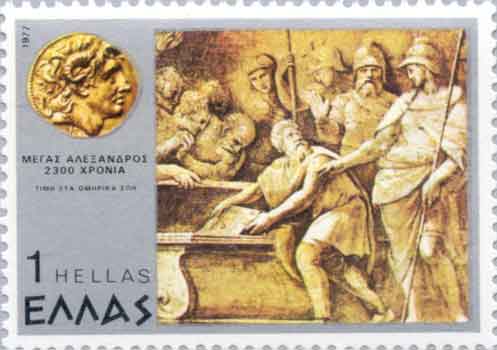
Alexander the Great honors the Work of Homer, a Greek stamp for Alexander 2300 years after his death
Quote: The Meaning of the Camaieus under Raphael's Parnassus. In Mh. f. Kunstw. VIII, 1915, pp. 10-16 (5 figs.), G. J. HOOGEWERFP reviews the question of the interpretation of the two paintings en grisaille under the Parnassus of Raphael and concludes that the view of Bartsch, repeated by Wolfflin, is the only tenable one. The left camaieu represents Alexander having his copy of the Iliad deposited in the coffer of Darius; the right, Augustus preventing the burning of the Aeneid.
R ?
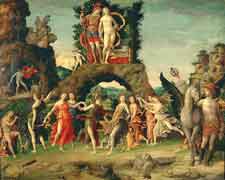
Andrea Mantega's Parnassus , 1497, , Louvre Paris, maybe influenced Raphael
Quote
"Thus on the poetic mount beside the source of Helicon the dream of Humanism is fulfilled in the joy of living and intellectual pleasures. The whole code of classic art is formulated in these unrivalled pictures. In them beauty, nobility of posture, purity and grace of form, the sense of rhythm and life--all combine to form one joyous whole. The serenity of Greek art is recovered without effort, and the noblest harmony is the result. It is the most complete expression of the magnificent ideal which for a time was believed realizable in the Church and which was called Humanism." Catholic Encyclopedia
Ingres: The Apotheosis of Homer
Archelaos: The Apotheosis of Homer
Grove of the Muses on Mount Parnassus drawing after Stackelberg. M. Maas, Das Antike Delphi. Orakel, Schätze, Monumente
Modern Versions of Apollo and the Muses:
John Singer Sargent, Apollo and the Muses , 1921, Museum of Fine Arts, Boston
| Ancient Greece
Science, Technology , Medicine , Warfare, , Biographies , Life , Cities/Places/Maps , Arts , Literature , Philosophy ,Olympics, Mythology , History , Images Medieval Greece / Byzantine Empire Science, Technology, Arts, , Warfare , Literature, Biographies, Icons, History Modern Greece Cities, Islands, Regions, Fauna/Flora ,Biographies , History , Warfare, Science/Technology, Literature, Music , Arts , Film/Actors , Sport , Fashion --- |

